The edge of Mongolia: A photographer finds peace while riding with the Tsaatan reindeer tribe
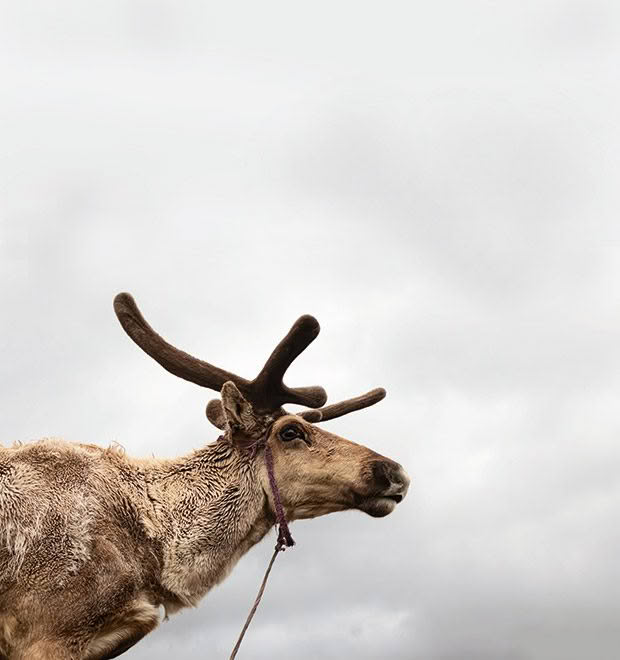
Evolution has provided subarctic reindeer with fur that repels water, antlers that regulate body temperature and a nose that warms icy air.
A photographer faces cold, rain and bolshy animals when he visits the Valley of the Reindeer. But what he discovers is a fairy tale.
Words & photos: Chris van Ryn
This is unexpected. I look around the terminal. It’s 4am. I am in Ulaanbaatar, capital of Mongolia, home to 1.4 million and the beginning of my journey to the fringes of subarctic Siberia.
In a few days, I will ride to the Tsaatan reindeer tribe in the Jigleg Valley, a remote location attainable only by horse. I once sat on a horse. For a few hours. Twenty years ago.
I am in Ulaanbaatar; my luggage is not. Three hours later, I’m flying to Murun in the Khuvsgul Province with what I’m wearing and a day pack. Meanwhile, for 10 days, I will walk and ride and sleep in the same clothes and, at the end of each day, smelling of horse, crawl into a borrowed sleeping bag.
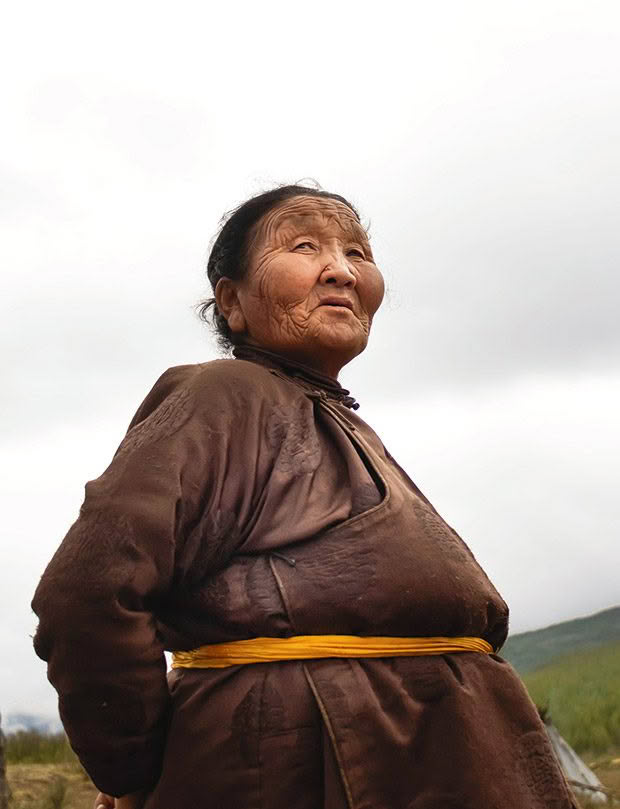
The Tsaatan tribespeople live in the remote Jigleg Valley near the Russian border, maintaining a culture that has changed little in 1000 years.
Below is a barren and parched panorama, an exquisite expansive emptiness. Treeless hills rise and fall, rise and fall, rise and fall, as if the land were gently breathing. A meditation.
Airplane becomes SUV. The Yamaat Canyon mountains are bald and rugged. Many are covered in rust-coloured stones, painting whole mountains terracotta.
There are herds of yak: long-haired, long-horned, bulky, prehistoric-looking bovines. Ragged fur hangs from their flanks. They move and chew, extracting the tiniest nourishment from bone-dry grass as it percolates through four stomachs. There is no mooing or bellowing, just a quiet, studious munching.
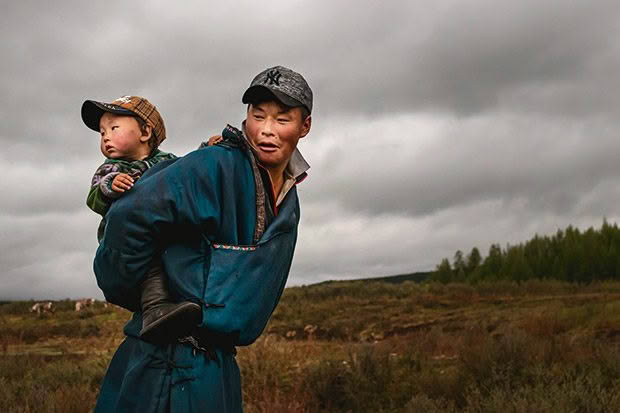
Vultures loiter on mountains like street hooligans, awaiting death and decay. They cast piercing looks over their razor-like, carrion-stripping beaks. Although raptors, they are not killers but undertakers, engineered for processing the dead.
A third eyelid protects against blood and flesh, and elastic stomach linings facilitate gorging. They are nature’s gold-standard recyclers. Once aloft, a tilt of wing catches air currents, transforming them into regal, three-metre winged gliders, circling at heights of up to seven kilometres.
On the curve of the horizon is a white spot. It grows to a snowy dome: a gur, home to a nomad. Beside the gur is the 4WD epitome of communist ideals — the ubiquitous Russian Furgon, gunmetal grey since 1965. It is the van of vans for nomads, who lovingly store spare parts under their beds.
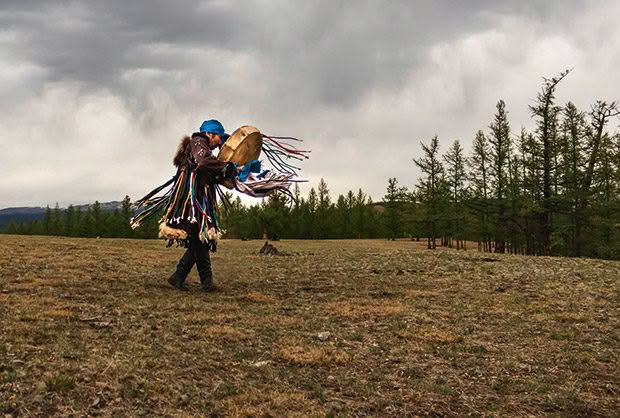
The ancient practice of shamanism is common among the Tsaatan. In a trance-like state, the shaman reaches out to worship ancestors. Shamanic belief includes indigenous medicines and profound respect for nature.
Herds of horses roam the plains, nuzzling each other’s flanks, bathing in wide rivers, tails swishing. They trot and neigh and toss their heads in freedom. They are the last of the world’s wild horses.
Twilight lingers. The day stretches. The nights truncate. SUV becomes a horse. A grubby, white, short-legged, stocky horse, with a broom-like mane and a crazy fleck in her eyes. I sit statue-still, gripping the reins.
Sudden movements, our guide Tulga warns, might get you thrown. With a sliver of disappointment, I relinquish control for comfort. Byambaa will guide us. She is rosy-cheeked and as robust as the horse. Without English, her default response to questions is to grin.
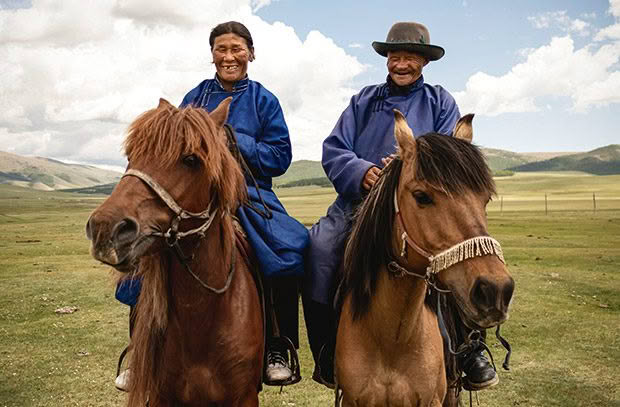
The horse remains an essential form of transport in a country that is one of the most sparsely populated in the world. Most people have little or no access to modern facilities.
She rides in front, pulling a rope attached to my horse. Wherever her horse goes, mine goes, albeit reluctantly, snorting and tossing.
“Nice accent,” I say to Tulga across the small shrubs between our horses. “Upper-class British.” Tulga laughs.
He wears a bandana, knee-length riding boots and a deel, a long traditional coat, black with a sash around the middle. Educated in the People’s Republic of Mongolia (1924 to 1992), Tulga also went to London to learn English.
“I was very anxious before coming to England in 1994,” he says poshly, reining his horse nearer mine. “I have been taught there were all murder in the street, bombing, shooting and burglary, raping all over places.”
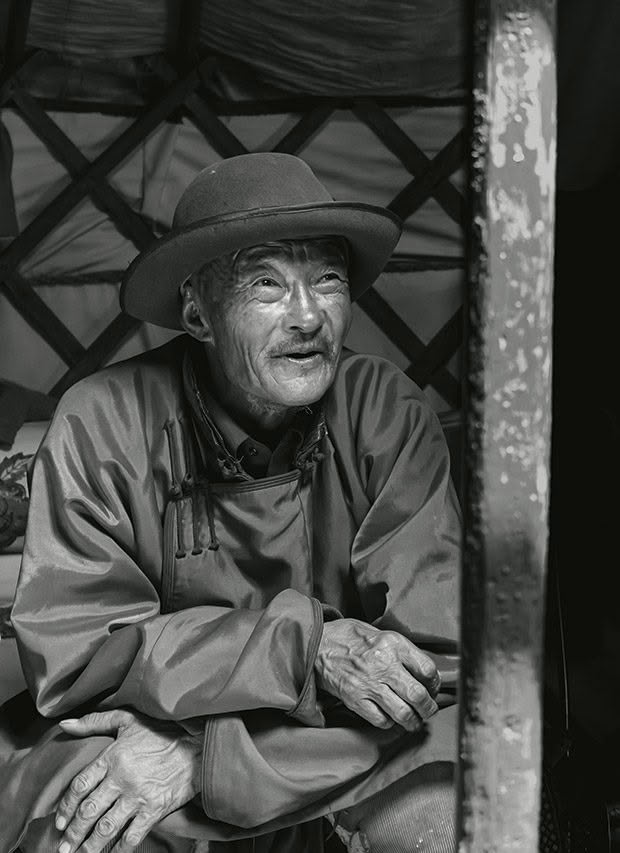
Some 27 years on, Mongolians are recovering communists, still adjusting to democracy and capitalism.
A mist creeps in, bringing the smell of rain. We squeeze between mountains and ride past glinting rivers of white. My horse pushes through swamp and scrub and long grass with soft pink flowers swaying in the afternoon breeze. Her sides ripple with effort. She’s warm and smells of sweat.
Then it rains. And rains. It rains on the only set of clothes I have. My knees ache. My feet are wrinkle-wet.
Between the mist and rhythm and song of drops, the Jigleg Valley comes into view.
The mountains wrapping the valley are a swampy coniferous forest: larch trees with slender, linear trunks, branches filigreed with needle-like leaves. A fast-flowing serpentine river bisects the valley.
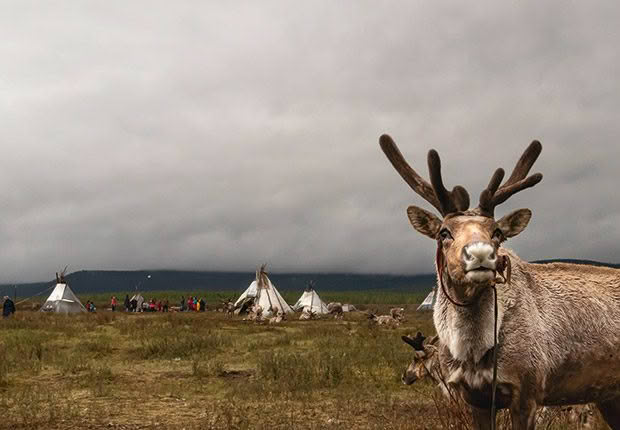
The Tsaatan have a symbiotic relationship with their reindeer, which meander between teepees.
Under angry grey skies are clusters of teepees. Whispers of smoke semaphore from their tops. Reindeer. A fairy-tale valley with fairy-tale creatures: adults with majestic antlers, fluted and fanning from an arch atop delicate fawny heads, bright-eyed babies with velvety nubs.
Clusters of reindeer are being herded across the river from a day of grazing for lichen. Others meander between people and teepees and shrubs, a front and rear leg bound together to keep them from running off. They make eerily human sounds, like snoring. Creatures of the cold, their antlers regulate body temperature, and dark, moist noses warm the icy air before it enters their lungs.
Then the fairy tale is interrupted. There are satellite dishes and solar panels and the dissonant sound of a chainsaw and a motorbike. We ride across the river, up to a post with an enormous set of bleached antlers pinned to it like a crucifix.
Nearby stands an elderly couple. They wear long grey deels, secured around the middle with bright yellow sashes. They are old. But how old? Men have a life expectancy of 65, women 75. And climate and toil have woven patterns on their leather faces.
“This is Ganbat and his wife Purevee,” Tulga says. They are tribal elders, offering age and advice. We grin and nod and shake hands.
I have my own teepee. It’s wrapped in thick charcoal canvas around long stakes, wide at the base, narrow at the top. A smokestack punctuates a hole at the top. A rusting potbelly sizzles when raindrops land on it. The triangular geometry pushes woodsmoke-scented heat down.
A teepee has no wall for artworks. No shelves for ornaments. No en suite. No kitchen. No mortgage. Around the perimeter, log beds with thin mattresses serve as seats. A bulb clipped to a car battery sways in the breeze.
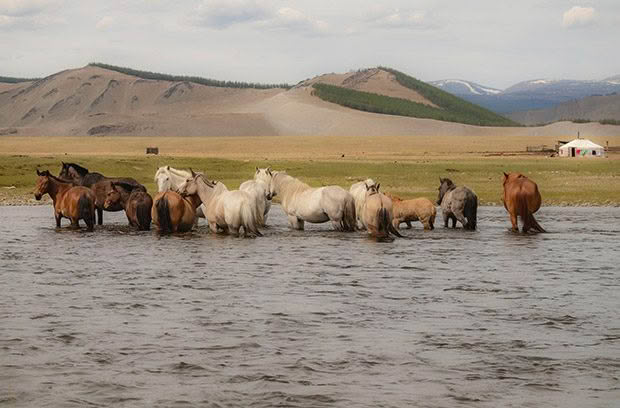
The tribe’s horses wander freely across the remote plains. The Mongolian wild horse or Przewalski horse is the last of the world’s wild horses.
Nomadic, the Taatsen follow nature’s ebb and flow, seeking an optimal supply of reindeer food. They unwrap, leaving a teepee skeleton, relocate, then rewrap over last season’s stakes. An en suite would be difficult to transport on the rump of a reindeer.
I dump my day pack on the bed and marvel at how little I have, how unencumbered I feel, and how in a week I’ll have a hot shower. A life with less is appealing. I strip and hang sodden clothes on strings between stakes. The teepee feels like a laundromat. I feed logs onto glowing embers and blow, watching smoke billow out. Flames flicker.
I walk around the rusty potbelly, with mud-cold soles, hands reaching towards the warmth, easing my aching knees. Gradually, pale turns pink, the goosebumps disappear, moisture dries. My skin glows. Spits of rain reach my face. The sounds of nearby reindeer seep into the teepee. The memory of the ride vibrates like a tuning fork and I’m aware of how alive I feel.
“We’ll get the kids to race the reindeer,” Tulga announces. He’s bounding around, grinning with enthusiasm. “I do it every time.”
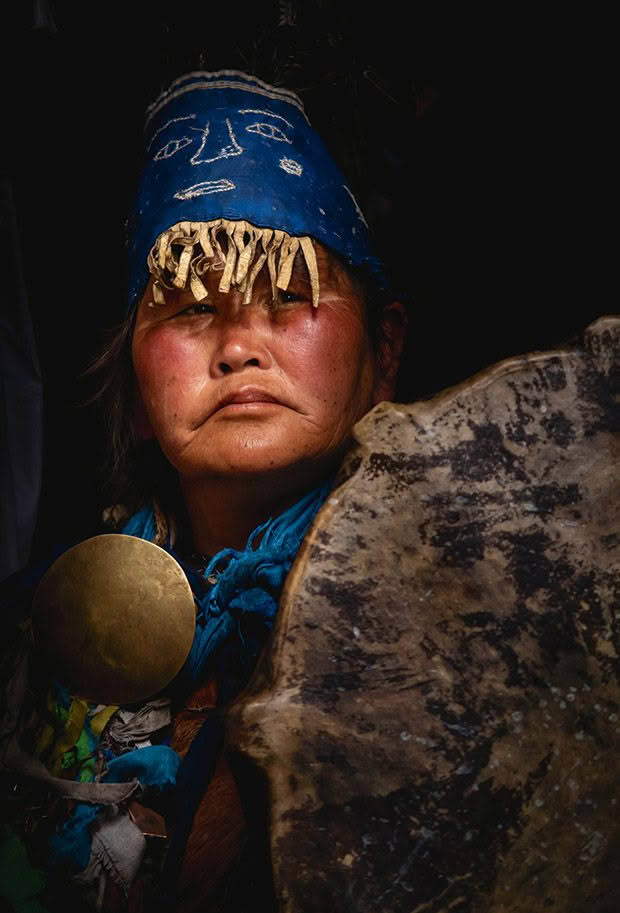
What he loves best is what happens when the race is over. He zaps out instructions to nearby kids. Soon children around the village are rushing to find their reindeer, grins matching Tulga’s. A dozen rosy-faced cherubs clamber onto their reindeer, assembling in a small field.
They’re off! They cajole and urge and prod and shriek their reindeer on, but in the end, children and beasts trickle over the finish line. One or two recalcitrant animals head in a different direction.
Everyone is laughing. Tulga, eyes sparkling, gives each child a tugrik note, which they receive solemnly in two hands, raising the currency to their faces, studying it in awe.
Mobile phones, chainsaws and motorbikes are fueled by tugrik. Reindeer produce yoghurt, cheese and milk tea, not SIM cards. Antlers, once used for tools, are sold as medicines and decorated with delicate images for growing tourism industry.
Children are sent to boarding school. Teenage boys return, called back by parents and the reindeer. The girls get smart haircuts and attend higher education. The world stage opens up. Tulga calls it the “gender problem”, and it threatens this 1000-year-old culture. The girls move to cities where feelings blossom for smart men and smartphones. They leave the reindeer boys to their reindeer.
Byambaa crosses a river. We are halfway up the mountain, the Valley of the Reindeer fast receding. I’m overwhelmed by the power of these horses. The tether spans the water. Then her horse clips a rock and missteps. It rears up. Byambaa flies into the air. Thump! She smacks the ground, her cheek meeting rock, water cascading around her.
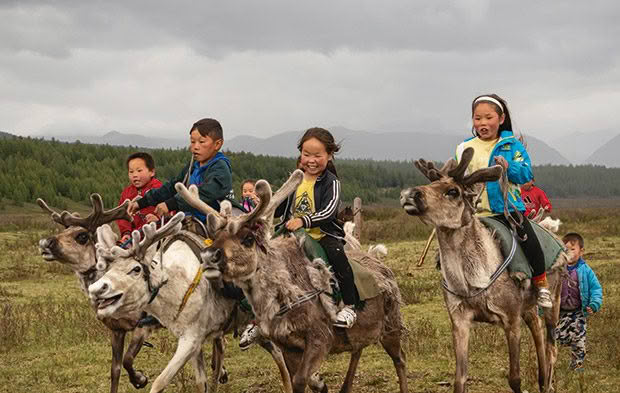
Children participate in a reindeer race. Everyone is a winner since each receives a tugrik note.
“Whoa! Whoa!” I’ve no time to think.
My horse jerks sideways, then rears, snorting. We collide with a tree, slamming my knee. I pull the reins. Hard. The horse snorts and jerks, mouth flaring against the bit. Shhh. I pat her neck. I feel her agitation. Whoa! Shhh. Shhh. She calms. Amazing. Did I just do that?
Byambaa is up. She gives an awkward laugh and her cheek is blushing. She walks to a tree, then places the bruise against wet leaves.
“I’m going on my own,” I say. Where did that come from? I cross the river, splashing through a shallow section and begin weaving through larch trees, feeling spikes of adrenaline. I guide my horse down a muddy slope.
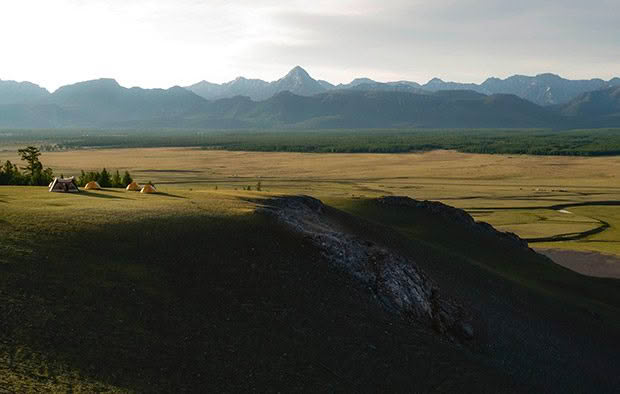
Tenting in Mongolia is to experience a sense of isolation. Nothing quite matches the early-morning view over open plains.
Surely her hooves will slide out from under? I lean back in the saddle, feet straining in the stirrups. At the bottom, she does a little tap dance, then steps over a large moss-green log.
For a while, we are knee-deep in swamp, her hooves sucked down by mud, beaded wet blades brushing my thighs. Rain seeps into my eyes. I pat my horse, feeling pleased. She snorts, shifting on her hooves. Fair play to her, she’s worked hard. I’m not independent. I’m interdependent.
Suddenly, something shifts for me. I see the carefully packed luggage I never missed; texts I didn’t write; an isolated valley on the edge of the Earth; the alluring minimalism of the Taatsen nomads; the slender-limbed forest, craggy mountains and rugged canyons; the regal cadaver-cleaning aviators and prehistoric bovine; women, heads flattened against flanks, milking fairy-tale reindeer; the sparsely populated plains of meditation; endless twilights casting me adrift from time, space and direction; the entire globe in gravitational rotation.
From this height, there are no lines between countries, and I think: we are all in this together.
NOTEBOOK
Getting there: Several airlines fly to Beijing or Hong Kong (Qantas or Air China). From there, take a Mongolian Airways flight to Ulaanbaatar.
Where to stay: Traveling to remote areas of Mongolia is not for the faint-hearted. Accommodation is usually a tent, and there are no facilities for showers or toilets (a toilet in the valley is an open-air long drop). An authentic teepee is provided in the Valley of the Reindeer.
Horsing around: Visiting the Valley of the Reindeer by horse requires an operator who can both organize and guide. No previous riding experience is needed, but a reasonable level of fitness is a must. Treat some discomfort as part of the experience. Riding has risks, like many other activities. A helmet will be provided, and a horse can be led if the challenge of riding solo proves too great. Tour operator Crooked Compass specializes in off-the-beaten-track tour packages, which cover about 10 days. The company’s on-the-ground operators are excellent.
Before leaving: Obtain visas from the Mongolian consulate in Newmarket, Auckland, or online. A permit is valid for three months.
See the city: Take a couple of days to tour Ulaanbaatar. It’s a rapidly developing city with many half-completed — and ugly — high rises, but it also has fascinating and authentic temples. Be sure to take in a local performance of throat singing, a style of singing or chanting that allows the singer to produce more than one note at a time.
Getting around: Cash is available from ATMs in Ulaanbaatar. Once outside the main city, there is no way of getting money. The Taatsen accept cash for the small souvenirs they make, and it is essential to their livelihoods.
Remember: For days there will no power supply, so take back-up batteries and a power bank.
Love this story? Subscribe now!
 This article first appeared in NZ Life & Leisure Magazine.
This article first appeared in NZ Life & Leisure Magazine.
